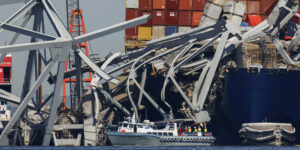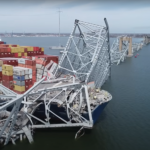Tokyo, the world’s most populated metropolis, is building defenses for the possibility of a flood in the next 200 years that could dwarf the damage superstorm Sandy wrought on the U.S. East Coast.
Japan’s capital, flanked by rivers to the east and west, as well as running through it, faces 33 trillion yen ($322 billion) in damages should the banks break on the Arakawa River that bisects Tokyo, according to government estimates. That’s more than five times the $60.2 billion aid package for Sandy that slammed into the U.S. northeast last October.
“Japan hasn’t prepared enough,” said Toru Sueoka, president of the Japanese Geotechnical Society, an organization of engineers, consultants and researchers. “Weather patterns have changed and we are getting unusual conditions. We need upgrades or else our cities won’t be able to cope with floods.”
In 2008, for the first time in human history, half of the world’s population lived in urban areas and that will rise to 60 percent by 2030, according to a World Bank report titled Cities and Flooding. The report says that trend combined with climate change means the world’s cities will bear the biggest loss of life and the largest economic costs from flooding.
Should the Arakawa River break its banks, about 2,000 people in Tokyo may lose their lives and around 860,000 will be stranded, according to the government. The waters would flood subway and regular train lines, crippling 97 stations.
Flood Defenses
The capital’s Edogawa City, one of Tokyo’s largest wards that is sandwiched by two major rivers, predicts it will cost 1.7 trillion yen to strengthen and rebuild the banks of the Arakawa and Edogawa rivers to prevent breaching during a flood, said Naomasa Tachihara, director of Edogawa’s department of public works planning.
Floods are the world’s most frequent destructive natural event and the costs of economic damage have surged, according to the 2012 World Bank report, citing examples in Pakistan, Australia, the Mississippi in the U.S., and Bangkok in Thailand in 2010 and 2011.
London’s effort to prevent flooding is a barrier spanning the River Thames completed in 1982; a three-decade project started after a flood in 1953 that killed 300 people.
The Thames barrier across a 520-meter stretch of the river was closed four times in the 1980s, 35 times in the 1990s and more than 80 times since, according to the Environment Agency.
Typhoon Kathleen
Sea levels around London will rise as much as 88 centimeters in the next century as warmer temperatures melt polar ice caps, the government estimates. The barrier’s 20-meter tall gates are designed to withstand the worst case scenario –a 2.7 meter increase by 2100.
In Tokyo in 1947, about 1,100 people died and 31,000 houses were destroyed when Typhoon Kathleen struck the capital and caused the Tonegawa River north of the city to break its banks, according to the Cabinet Office. A repeat of that flood today with a larger concentration of people and property in the capital would cause catastrophic damage, the government says.
A storm tidal surge in Tokyo Bay may be the most devastating for the capital, leading to 7,600 deaths and flooding an area housing 1.4 million people, according to government estimates.
“We don’t know where could be next,” said Tomohito Noumi, an assistant manager in the river improvement and management section of the nation’s land ministry. The defenses need to be stronger, he said.
35 Million People
Metropolitan Tokyo, which spreads out around a bay and covers an area of 1,782 square kilometers, eclipsed New York- Newark as the world’s most highly populated area in 1975. Now it has 35 million people, compared with 19 million in New York- Newark, according to data compiled by the United Nations.
The United Nations estimates that investments in infrastructure and technology to mitigate the effects of climate change, including flooding, will total as much as $130 billion a year by 2030.
Arcadis NV, a Dutch engineering company that offers flood- protection services, has been growing through acquisitions, most recently snapping up ETEP, a Brazilian water engineering and consulting firm.
Arcadis’s revenue rose 26 percent last year to 2.5 billion euro ($3.2 billion). The company won contracts from New York’s Nassau County and New York City to help bring water treatment facilities back online after Sandy.
Protection
“The money spent on clean-up, repair and the loss of business in the aftermath can outweigh the costs of taking preventive measures and governments are starting to look at opportunities to protect themselves,” said Piet Dircke, who oversees water management at Arcadis.
Japan plans to spend 1 trillion yen on nationwide disaster prevention, including strengthening levies, in the fiscal year started April 1, according to the transport ministry.
Tokyo’s Edogawa, the fifth-most populated of Tokyo’s 23 districts or wards, is most at risk in the capital because it’s penned in by the Arakawa River on one side, the Edogawa River on the other, and faces Tokyo Bay, said Tachihara from the public works planning department.
“Edogawa is shaped like a basin, with the levees being the edges,” he said. “Without levees 70 percent of Edogawa would be underwater in a storm.”
Samurai Shovels
Tokyo has spent centuries changing the course of rivers and building levees to reduce flooding.
Shogun Ieyasu Tokugawa, the first samurai to unite Japan in 1600 and who became shogun three years later, ordered river diversions 400 years ago.
He decided to change the course of the Tonegawa, Japan’s second-longest river, so it flowed into the Pacific Ocean rather than through Tokyo, then known as Edo.
It took three generations to complete, with Ieyasu’s grandson Tokugawa Iemitsu finishing the job, according to the Geotechnical Society’s Sueoka.
“Tokyo has been building defenses against floods since the Edo government,” said Tachihara. “What we’re doing now is for the future. We’re preparing for a once in 200 years event.”
About 40 kilometers (25 miles) north of Tokyo is another flood protection project, the Metropolitan Area Outer Underground Discharge Channel.
Statue of Liberty
A shaft tall enough to house the Statue of Liberty has been built to feed water from five rivers into a reservoir carved underground. The space, big enough to hold four Parthenons, is supported by 59 columns each weighing 500 tons.
A 6.3-kilometer underground tunnel draws flood waters to the reservoir, which has four of the engines used on Boeing Co. 737 passenger jets to pump away as much as 200 cubic meters of water a second.
“The amount of flooding in the area has dropped significantly since we started operations,” said Takashi Komiyama, who manages the facilities that took 13 years and 230 billion yen to build.
“We used to be prepared for about 50 millimeters of rain an hour, but now we need to be ready for 100 millimeters or 120 millimeters,” said the geotechnical society’s Sueoka. “It’s difficult to think in terms of 100 or 200 years to secure the nation’s safety, but that’s what it takes.”
With assistance from Scilla Alecci in Tokyo and Reed Landberg in London. Editors: Peter Langan, Teo Chian Wei




















 E&S Property In Focus: Competition Up, Price Momentum Waning
E&S Property In Focus: Competition Up, Price Momentum Waning  Allstate’s Safe Driving App Helps Reduce Chance of Collision by 25%
Allstate’s Safe Driving App Helps Reduce Chance of Collision by 25%  Maritime Law Invoked By Ship Owner in Baltimore Bridge Collapse to Cover Salvage Costs
Maritime Law Invoked By Ship Owner in Baltimore Bridge Collapse to Cover Salvage Costs  Progressive Gains as Drivers Shop Around for Auto Insurance—Again
Progressive Gains as Drivers Shop Around for Auto Insurance—Again 